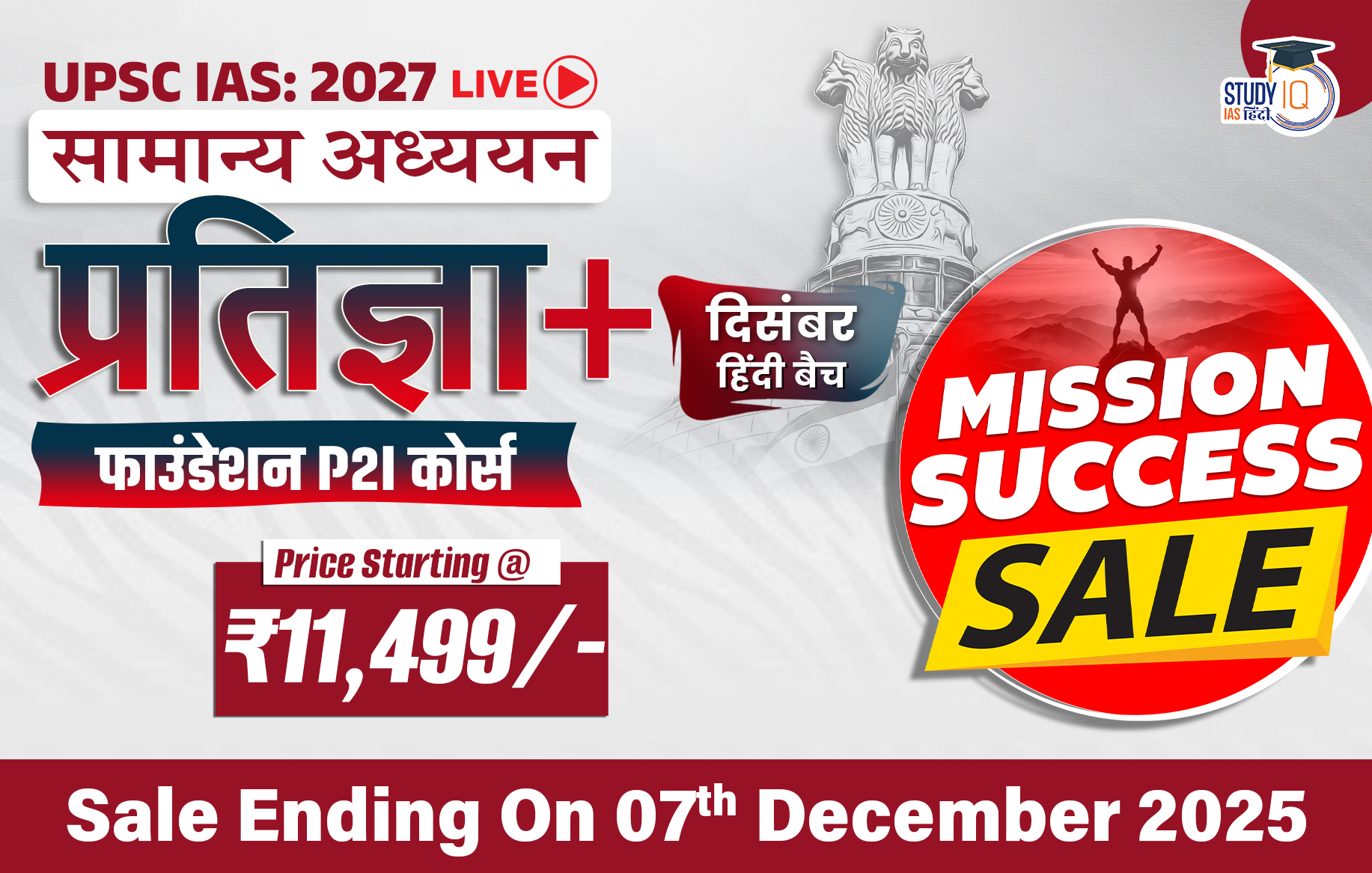UPSC Prelims News of 24 January 2023
Rathole Mining
Context: A High Court-appointed committee has refuted claims made by the Meghalaya State government on hazardous rat-hole mining.
- It is a mining technique that involves digging narrow tunnels, each of which fits only one person to enter and extract coal.
- Reasons: The coal seam is extremely thin in Meghalaya; the open-cast method would not be economically viable.
- Removal of rocks from the hilly terrain and putting up pillars inside the mine to prevent collapse would be costlier compared to the locally developed technique.
- Impact of rat-hole mining:
- Large number of people have lost their lives due to the collapse of these mines or due to flooding.
- The open dumping of extracted coal is a major source of air, water and soil pollution.
- Mining-related waste has polluted many important rivers in the area, turning them acidic and unfit for consumption.
UPSC Prelims News 23 January 2023
Charaideo Maidam: Assam
Context: Charaideo Moidams (pyramids) of Assam will be India’s nomination for UNESCO’s world heritage site status in the cultural category for 2023-24.
- Moidams are the Mound-Burial System of the Ahom Dynasty. They represent the late medieval (13th—19th century CE) mound burial tradition of the Tai Ahoms in Assam.
- Charaideo exclusively contains moidams of Ahom royals, while other moidams of aristocrats and chiefs can be found scattered across Eastern Assam.
- There are about 386 Moidams explored so far, but the 90 royal burials at Charaideo are the best preserved, representative, and most complete examples of this tradition.
- The Charaideo Moidams host the mortal remains of Ahom royalty—previously, those of the deceased with their paraphernalia were also buried.
- After the 18th century, the Ahom rulers adopted the Hindu method of cremation, later entombing the cremated bones and ashes in a Moidam at Charaideo.
- Structure of Moidams:
- A typical moidam is made up of one or more chambers in a vault. On top of these is a hemispherical earthen mound, rising high above the ground, covered in grass.
- On top of this mound, there is a pavilion, known as the chow chali. A low octagonal wall surrounds the mound with one entrance.
- Ahoms:
- Ahoms were one of the longest-ruling dynasties in India. They trace their origin to South Chinese ruling dynasties.
- At their peak, their kingdom included modern-day Bangladesh till deep inside Burma.
Municipal Bonds
Context: The Securities and Exchange Board of India has launched an information database on municipal bonds.
What are Municipal Bonds?
- A municipal bond (muni) is a debt security issued by a state, municipality or county to finance its capital expenditures, including the construction of highways, bridges or schools.
- Significance:
- They are critical for India’s large cities and towns to upgrade their creaking infrastructure.
- The ability of municipal bodies to be self-sustaining is also critical to the success of the Centre’s pet projects such as Smart Cities and AMRUT.
- Differences between normal bonds and municipal bonds:
| Normal Bonds | Municipal Bonds | |
| Issuer | Normal bonds are issued by companies and corporations. | Municipal bonds are issued by municipalities or municipal corporations. |
| Tax Status | Interest earned on normal bonds is subject to income tax. | Interest earned on municipal bonds is tax-exempt at the federal level |
| Purpose of issuance | Normal bonds are issued for various purposes such as expansion, modernization, or to raise capital for a new project. | Municipal bonds are issued to finance public projects such as building schools, highways, and water treatment plants. |
| Rating | Normal bonds are rated by credit rating agencies. | Municipal bonds are rated by credit rating agencies registered with the SEBI. |
| Liquidity | They have higher liquidity. | Municipal bonds have lower liquidity. |
| Regulations | Issuance and listing are governed by the SEBI (Issue and Listing of Debt Securities) Regulations, 2008. | Issuance and listing are governed by the SEBI (Issue and Listing of Municipal Debt Securities) Regulations, 2015. |
SEBI (Issue and Listing of Municipal Debt Securities) Regulations, 2015
- Eligibility criteria for issuing municipal debt securities: The issuer must be a municipality or a municipal corporation, as defined under the respective state/union territory laws.
- Issuance of municipal debt securities: The issuer must comply with the regulations of the Reserve Bank of India (RBI) and the Securities and Exchange Board of India (SEBI) for the issuance of debt securities.
- Listing of municipal debt securities: The issuer must list the debt securities on a stock exchange recognized by the SEBI.
- Disclosure and transparency: The issuer must provide full disclosure and transparency to investors, including information on the use of proceeds, financial statements, and any other relevant details.
- Credit rating: The issuer must obtain a credit rating from a credit rating agency registered with the SEBI.
Netaji Subhas Chandra Bose
Context: January 23 is the birth anniversary of Netaji Subhas Chandra Bose, observed as Parakram Diwas.
- Netaji was born on 23rd January 1897, in Cuttack, Orissa Division, Bengal Province, to Prabhavati Dutt Bose and Janakinath Bose.
- In 1919, he cleared the Indian Civil Services (ICS) examination (resigned later).
- He considered Swami Vivekananda as his spiritual Guru and his political mentor was Chittaranjan Das.
- He stood for unqualified swaraj (independence) and opposed the Motilal Nehru Report which spoke for dominion status for India.
- He actively participated in the Salt Satyagraha of 1930 and opposed the suspension of the Civil Disobedience Movement and the signing of the Gandhi-Irwin Pact in 1931.
- The INA included both the Indian prisoners of war from Singapore and Indian civilians in South-East Asia. Its strength grew to 50,000.
- The INA fought allied forces in 1944 inside the borders of India in Imphal and in Burma.
- Due to ideological differences with Gandhi, Bose resigned and left congress and founded a new party, ‘the Forward Bloc’.
- He started the newspaper Swaraj and took charge of publicity for the Bengal Provincial Congress Committee.
- He reached Japanese-controlled Singapore from Germany in 1943, issued from there his famous call, ‘Delhi Chalo’, and announced the formation of the Azad Hind Government and the Indian National Army on 21st October 1943.
- Important slogans: Jai Hind, Give me blood and I will give you freedom, Chalo Dilli, Itmad (Faith), Ittefaq (Unity) and Kurbani (Sacrifice).
- He is said to have died in 1945 when his plane crashed in Taiwan.
Under Pradhan Mantri Kisan Samman Nidhi (PM-KISAN)
Why in News? The Centre is expected to enhance the income support to farmers under the PM-KISAN scheme to `8,000 from `6,000/year.
About:
- PM Kisan is a Central Sector scheme with 100% funding from the Government of India.
- It was launched in 2019 to supplement the financial needs of the farmers in procuring various inputs to ensure proper crop health and appropriate yields, commensurate with the anticipated farm income.
- Under the scheme, income support of 6,000/- per year in three equal instalments will be provided to all land-holding farmer families.
- The fund will be directly transferred to the bank accounts of the beneficiaries.
- It is being implemented by the Ministry of Agriculture and Farmers Welfare.
Inflation Targeting
Why in News? Recently, a new IMF Working Paper has concluded that formal adoption of inflation targeting (IT) is neither necessary nor sufficient for attaining low inflation outcomes.
About:
- It is a central banking policy that revolves around adjusting monetary policy to achieve a specified annual rate of inflation.
- Its principle is based on the belief that long-term economic growth is best achieved by maintaining price stability, which is achieved by controlling inflation.
- Inflation targeting is known to bring more stability, predictability, and transparency in deciding monetary policy.
- The RBI is mandated to maintain a rate of inflation of 4% with a 2-percentage-point deviation, i.e., inflation must be kept between 2% and 6%.
School Health and Wellness Program
Why in News? It has been nearly three years since the School Health and Wellness Programme was launched.
About:
- The School Health Programme (SHP) under Ayushman Bharat was launched by the Prime Minister in Bijapur, Chhattisgarh.
- It is a joint collaborative programme of the Ministry of Health and Family Welfare and the Ministry of Human Resource Development (now the Ministry of Education).
- The programme targets both Education and Health domains and aims to facilitate an integrated approach to health programming and more effective learning at the school level.
- A total of eleven themes have been identified under the SHP which include Reproductive Health and HIV Prevention and these modules create awareness on the subject among adolescents.
Swami Sahajanad Saraswati
Why in News? Union home minister will be attending the birth anniversary ceremony of peasant leader Swami Sahajanand Saraswati.
About:
- Swami Sahajanand Saraswati was an ascetic, a nationalist and a peasant leader of India.
- Although born in present-day UP, his social and political activities focussed mostly on Bihar in the initial days, and gradually spread to the rest of India.
- The Bihar Provincial Kisan Sabha (BPKS) was founded by Saraswati in 1929 to address peasants’ complaints about zamindari attacks on their occupancy rights and served as the foundation for the farmers’ movements in India.
- The All-India Kisan Sabha (AIKS) was established at the Lucknow session of the Indian National Congress in April 1936, with Saraswati chosen as its first President.
- Subhash Chandra Bose and the All India Forward Bloc decided to observe April 28 as All-India Swami Sahajanand Day in protest of his arrest by the British Raj during the Quit India Movement.
Agriculture Infrastructure Fund (AIF)
Why in News? Within two-and-a-half years of the implementation of the AIF, the scheme has mobilized more than Rs.30,000 crore for projects in the agriculture infrastructure sector.
About:
- It is a pan India Central Sector Scheme launched in the year 2020.
- Duration: Extended to 13 years (FY2020 to FY2032).
- It aims to provide a medium – long-term debt financing facility for investment in viable projects for post-harvest management Infrastructure and community farming assets through interest subvention and financial support.
- For APMCs, interest subvention for a loan up to Rs. 2 crores will be provided for each project of different infrastructure types.
- NABARD will steer this initiative in association with the Ministry of Agriculture and Farmers’ Welfare.
- Intended beneficiaries: Primary Agricultural Credit Societies (PACS), Marketing Cooperative Societies, Farmer Producers Organizations (FPOs), Self Help Group (SHG), Farmers, Multipurpose Cooperative Societies, Agri-entrepreneurs, Startups etc.
Additional Tier 1 Bonds (AT 1 bonds)
Why in News? Recently, Yes Bank said it will move the Supreme Court against the order of the Bombay High Court to write off the additional tier-I bonds of up to Rs 8,300 crore.
About:
- AT1 bonds, also called perpetual bonds, carry no maturity date but have a call option.
- The issuer of such bonds may call or redeem the bonds if it is getting money at a cheaper rate, especially when interest rates are falling.
- They are like any other bonds issued by banks and companies but pay a slightly higher rate of interest compared to other bonds.
- AT-1 bonds are regulated by the Reserve Bank of India (RBI).
- These bonds are also listed and traded on the exchanges. So, if an AT-1 bondholder needs money, he can sell it in the secondary market.
- Investors cannot return these bonds to the issuing bank and get the money.


 UPSC Prelims News 17 March 2023
UPSC Prelims News 17 March 2023
 UPSC Prelims News 7 March 2023
UPSC Prelims News 7 March 2023
 UPSC Prelims News 1 March 2023
UPSC Prelims News 1 March 2023

























